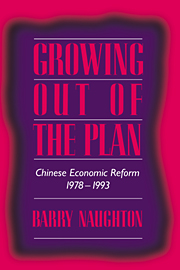Book contents
- Frontmatter
- Contents
- Tables and figures
- Preface
- Introductory
- Phase one The bird in the cage, 1979–1983
- Phase two Reforms take off, 1984–1988
- 5 Reformulation and debate: The turning point of 1984
- 6 The second phase of reform, 1984–1988
- 7 Rapid growth and macroeconomic imbalance
- Phase three To a market economy
- Statistical appendix
- Notes
- Bibliography
- Index
5 - Reformulation and debate: The turning point of 1984
Published online by Cambridge University Press: 03 May 2010
- Frontmatter
- Contents
- Tables and figures
- Preface
- Introductory
- Phase one The bird in the cage, 1979–1983
- Phase two Reforms take off, 1984–1988
- 5 Reformulation and debate: The turning point of 1984
- 6 The second phase of reform, 1984–1988
- 7 Rapid growth and macroeconomic imbalance
- Phase three To a market economy
- Statistical appendix
- Notes
- Bibliography
- Index
Summary
The peculiar combination of success and failure in China's economic reforms during the period from 1978 through 1983 triggered a reassessment of China's economic condition and the proper approach to economic reform. Accomplishments had been considerable. The most important goals of economic reorientation had been achieved, ameliorating imbalances and building reserves. The vigorous growth of the non – state sector had contributed substantial dynamism to the economy. As a result of these economic changes, the overall outlook of the leadership swung from pessimism to optimism. At the same time, the unbalanced progress of reforms in the state sector led to intensified debate about the proper way to reform. The rationalizing reform approach had failed. This approach had failed in the generic sense – that of not having qualitatively changed the behavior of state-run enterprises. But even more important was that the government had discovered itself unable to carry out the basic prerequisites of rationalizing reform, in the form of the initial rationalization of the financial and price systems. The model of reform was a shambles, but reform itself – in the form of vigorous growth in agriculture and non – state enterprises – was alive and successful.
This peculiar combination of success and failure touched off a process of reassessment and reformulation among the Chinese leadership. Since Zhao Ziyang was increasingly making the key decisions about individual reform measures, he was also the central figure in this process.
- Type
- Chapter
- Information
- Growing Out of the PlanChinese Economic Reform, 1978–1993, pp. 173 - 199Publisher: Cambridge University PressPrint publication year: 1995



